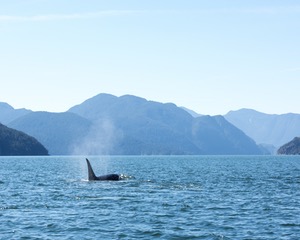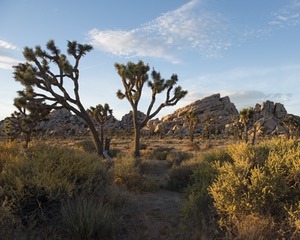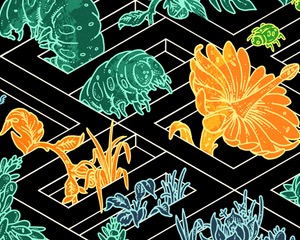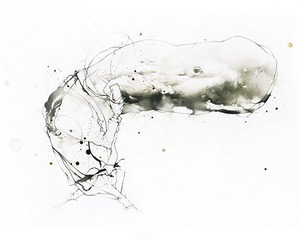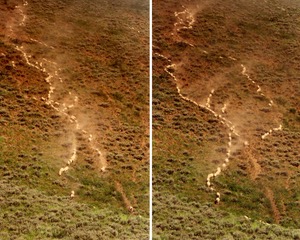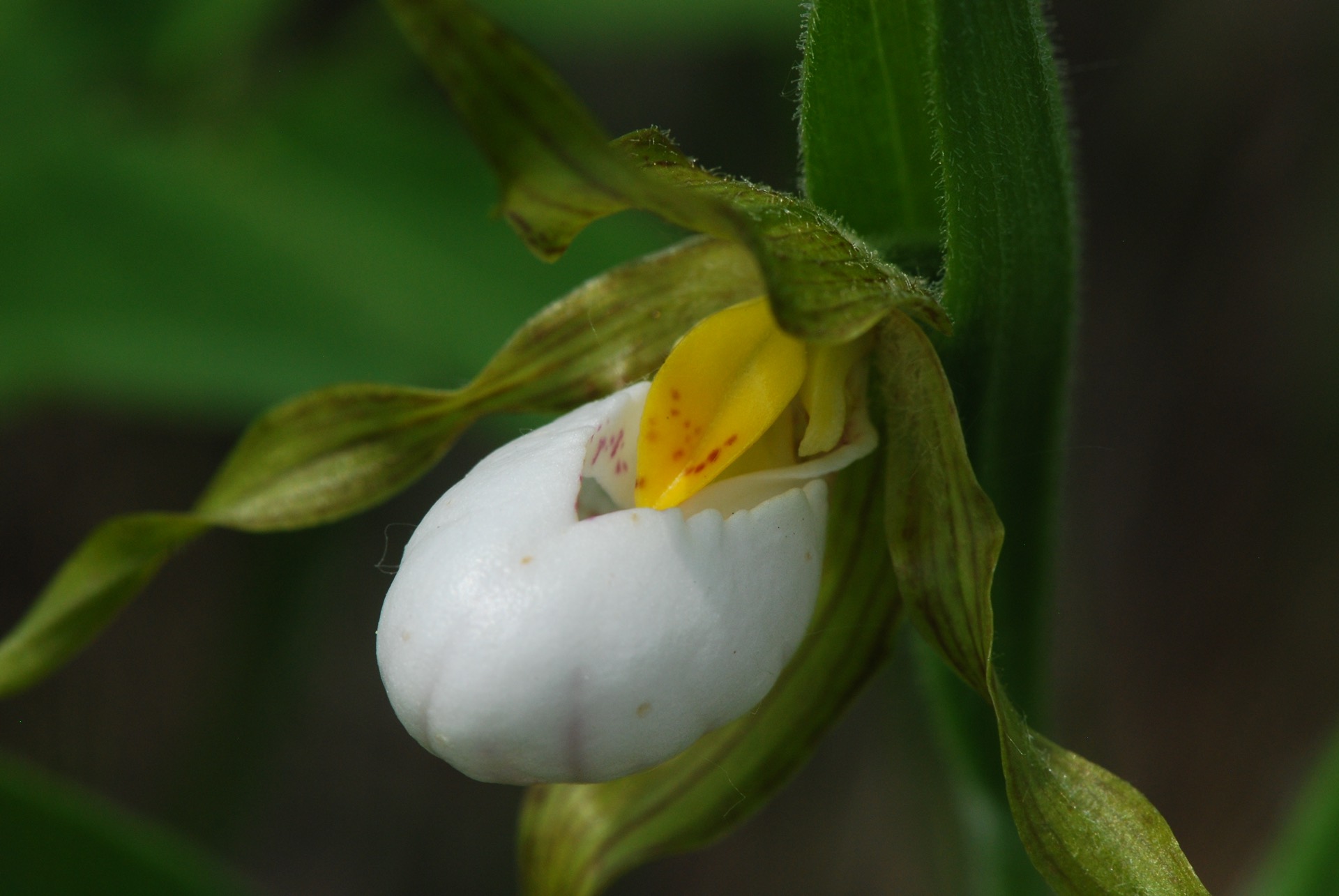
Cypripedium candidum, small white lady’s slippers, a protected wild plant increasingly rare in Pennsylvania
Joshua Mayer CC BY-SA 2.0
Pennsylvania’s Best Kept Secret: An Interview with Conservationist Rebecca Bowen
By Gayil Nalls
Sign up for our monthly newsletter!
Gone from Pennsylvania’s lush landscapes are many plant species and many more could follow, including a rare wild orchid called the small white lady’s slipper and the herbaceous perennial blueheart. Also in need of conservation are special grasses such as Leiberg’s panic grass and tall bentgrass.
To stop such grievous loss, Pennsylvania’s native plant species have been put under the protection of a cabinet-level agency called the Department of Conservation and Natural Resources (DCNR). It has been charged with protecting and conserving the state’s precious native, wild, and rare plants. We love sharing good environmental news and Pennsylvania recently designated 35 new sanctuaries with such low-profile locations that it may make them the state’s best kept secret.
We spoke with Rebecca Bowen, a Conservation Science and Ecological Resources Division Chief for the Bureau of Forestry in Pennsylvania Department of Conservation and Natural Resources, about their bold efforts to manage and protect plant species.
Word is that Pennsylvania is pursuing bold actions to safeguard their plant biodiversity. How is Pennsylvania’s Department of Conservation and Natural Resources (DCNR) ensuring that native plants of Pennsylvania are protected and stay in this world?
We are the state agency in Pennsylvania that has jurisdictional authority for plants. We have the responsibility to list all the classified, endangered, threatened and rare species. We maintain a list of different species and keep track of the threats to them. Invasive species are a big threat, as is climate change and shifting habitat availability. To protect critical biodiversity, we actively manage of the habitats that are in Pennsylvania for these rare, threatened, and endangered species.
One of the things that DCNR has the ability to do is set up wild plant sanctuaries. We can do that on both state lands and state forest land, but we can also create sanctuaries on park or state game land. But protecting plants can go beyond these state sites. The DCNR can also set up wild plant sanctuaries on private lands if a landowner has an especially good habitat for rare, threatened, or endangered species, a unique assemblage of species, or plants that sustain rare moths, butterflies or other arthropod—then that area can be eligible for a wild plant sanctuary designation.
What qualifies a plant for such care and does the plant’s relationship to other wildlife, pollinators and biodiversity of habitat, create any hierarchy in how you go about preservation?
Our classifications are derived from the Wild Resource Conservation Act created in 1982, which laid the groundwork for DCNR to be able to list threatened and endangered plant species and how to set up the classifications of endangered, threatened, extricated, and a couple of other different ones that we ended up combining. When DCNR took that charge they created a regulation called Conservation of Native Wild Plants which laid out exactly how we’re going to protect native wild plants and conserve them in Pennsylvania.
Did the Wild Resource Conservation Act lay out management techniques?
Hands on management techniques aren’t in the regulations of the Wild Resource Conservation Act. The purpose of this act is to preserve and enhance flora and fauna species, including those that are rare, threatened, endangered, tentatively undetermined, and extricated, which means it’s not found in Pennsylvania anymore.
How many plants are on that list?
Nature doesn’t stand still. It’s constantly changing and we’re constantly learning things about the natural world. We updated our definitions, classifications and regulations in 2018 and we hope to do another update in the next couple years, but currently there are 102 species listed as extricated— which means no longer found in Pennsylvania. There are 232 listed as endangered, which means they’re in danger of becoming extricated. There’s no numbers associated with this because it can vary depending on the populations. Threatened means the species is in danger of becoming endangered and there’s 78 in that category. There’s 39 species that are considered rare, which is really just limited geographic distribution and founded low numbers. So could be something that is only going to be found in the Philly region, maybe. Very restricted habitat or maybe on like the Erie Plain, that type of thing. So there’s 39 of those. There’s 128 in that tentatively undetermined category. And those species, many of them were put on in the eighties. And so we’re working to clean that list up and get them off of their because we know a lot more about them now.
Another category that I haven’t talked about yet is Pennsylvania vulnerable. That’s plants like ginseng, golden seal and yellow lady slipper. Those are species that have a commercial or economic value, but might be in danger of being over collected in the wild so they’re on this special vulnerable list, for which we have special rules. You have to get a license to sell them out of state and ginseng is managed also internationally. We actually answer to the U.S. Fish and Wildlife Service for data on ginseng commerce outside of Pennsylvania to make sure that the collection of ginsengs isn’t going to harm the natural populations.
Are there well-known wildflowers that are endangered?
The blue-ridge false foxglove and the northeastern bulrush, a type of sedge grass, that is a vulnerable species, are good examples, but most endangered species are more likely to not be very well known, because they are rare, and not very common, and not where people see them a lot.
However, a good example of a species that has gotten a lot of attention in recent years because of the monarch butterfly is white milk weed (Asclepias perennis).
This gets us back to the early part of your question, about the connection between native plants that might be endangered and symbiotic wildlife. There’s a lot of different types of milk weed. This one is a white milk weed. It was listed back in the ’80s as tentatively undetermined because there was questions about it like, “Well, is it really all that rare? We didn’t really know.”
We have gotten a lot more data since then, and we were able to change the classification to ‘Pennsylvania endangered’ because in 2014 we learned that only three records were known for white milkweed and they were all in the central Pennsylvania area. So, it’s a very limited habitat. Very, very limited population. You can imagine if one of those populations gets destroyed by a development or something like that, then you’ve only got two. That’s an example of a species that we knew was maybe on the verge. And then over the years, we learned a lot more about them, and were able to more accurately list those species as endangered. This happened because it one of those species that is really important to the monarch butterfly.
What happens once a plant is put on that list?
It becomes a threatened or endangered species. It goes on the Pennsylvania Heritage Program’ online referenced database called the Pennsylvania Natural Diversity Inventory. It’s a tool that citizens can use when trying to get a DEP permit for a development project, let’s say, or if you need to construct a new bridge or something like that. You get onto this tool and draw in your project. It houses all of the data of threatened and endangered species and other species of concern that might not be currently listed as threatened or endangered, like migratory birds, which might not be threatened or endangered, but you’re also still not supposed to be impacting them with projects.
Someone can draw their project in and it analyzes the data— known areas where these species tend to be, and it gives you a receipt that says, “You might have a potential impact with this species and you should contact this agency for follow up,” or it says, “Based on our best available knowledge, it doesn’t look like there’s any species that you need to worry about in that area. No known threatened or endangered species, or species of concern seem to be impacted by this project.” I mean, of course there’s always a question because people haven’t been out surveying every inch of the state for every species possible, so it’s just based on our best available knowledge. But that’s one major way that we try to protect and conserve threatened and endangered species through using this PNDI tool (Pennsylvania Natural Diversity Inventory). So when DEP grants a permit, they have to make sure that no threatened or endangered species are going to be impacted.
It’s wonderful that Pennsylvania has created 35 new sanctuaries. Could you tell us about this conservation strategy to help imperiled plant species and protect their adaptive capacity?
Yes, all together there are close to 80 wild plant sanctuaries that we either informally, or formally manage on state forest land. We just formally made the designation of 35 new wild plant sanctuaries that will also be officially managed.
Other than removing invasive species around them, what other types of management might be done in their behalf?
In some cases, there’s invasive species management that takes place. Barberry is a really bad invasive plant. It tends to grow along roadsides or other right of ways. If an opening happens in the forest, either caused by a blow down, a timber sale, or a new trail gets is created, barberry can come and invade. It’s a species for which we do a lot of management. Some wild plant sanctuaries on state forest land don’t really need that much management. They’re very unique places, like a bog with a quaking bog mat where the plants assessed without a canoe. These special places are monitored regularly for invasive plants, plant populations are assessed, and we keep a handle on the health of the habitat.
I’ve heard that the locations of the new sanctuaries are being kept a secret. Is that true?
I wouldn’t call them secret, but poaching is a problem. Some people just think it’s a pretty plant and they take it home where the chances are it’s going to die because it’s a plant that’s rare and it’s growing where it’s growing for a reason. We want to deter people from trying to love things too much and taking them home with them. There are many orchid species that are threatened or endangered that are poached from wild plant sanctuaries, because there is a black market for orchids. This is something that we take seriously. We don’t want people to use location information to take plants out of the population. This harms the already small and vulnerable population.
I dislike when news media calls them “secret plant sanctuaries”. I wouldn’t really call it that, but it is true. We’re not disclosing all the location names because we want them to remain plant sanctuaries.
You have a white lady slipper, which is a wild orchid that is on the endangered list of Pennsylvania. Is that one that’s poached?
Yes, all the orchids are what we call sensitive species. All of our resource agencies have sensitive species – species that are vulnerable to collection. All the orchids are considered sensitive. Turtle species in general are considered sensitive, because turtles are cute. People want to take them home and make them into pets, so we don’t their location data out to the public. It’s just erring on the side of caution.
At World Sensorium/Conservancy, we publish information to help people address the conservation needs of their properties. I was very interested that Pennsylvania is partnering with the private citizens to create plant sanctuaries. How does that work?
It’s a program that we offer. We call them private wild plant sanctuaries. Any private citizen can come to us and say that they would like to have a wild plant sanctuary. The purpose is to increase good habitats for rare species. The point is to set aside really great habitats for threatened, endangered, rare, vulnerable populations and in some cases, it could be restoring habitat.
If someone in the state has an area that they know had a species, or maybe have some anecdotal evidence that a species used to be there, it could be something that they would want to work towards to improve the habitat with maybe invasive species management. Or if, let’s say, it’s an area that’s grown in and become more of an enclosed canopy and this particular species in the area likes an open sunny habitat, maybe some select removal of overstory would be a good idea. So those are some of the things that we would look at like that people are doing active management to benefit the species that are there.
These plant sanctuaries are not a garden-type situations where somebody went to Lowe’s and bought all these native things from the plant stand and put them in their backyard and call it a plant sanctuary. Although it’s better than barberry, we stay away from that kind of situation. On the other hand, there are private plant sanctuaries that are bolder field situations with really interesting or unique natural communities such as ones of ferns and lichens and mosses—good habitats that are well managed.
Some areas in the country have relocation programs for native plants to save them from development. The native plants are made available to land and homeowners that want to help restore their property. Do any rewilding programs like that exists in Pennsylvania?
The DCNR doesn’t manage any ecology restoration programs like that, but I think that’s a great idea. We would like to be more involved with real hands-on things like that. We’re trying to get more involved with the native nurseries and more engaged with landowners and getting the native species into landowners’ hands. I will say that with the environmental review that I was describing before using the Pennsylvania Natural Diversity Inventory, we really like to keep the species where they are. If that’s at all possible, we try to avoid the impact of new construction first, and then we talk about how to minimize that impact and lastly mitigating the impact.
Part of the mitigation could be moving plants to another location, but remember what I said before about loving the plants to death. They’re rare; they grow in a specific habitat for a reason. If you take them and put them someplace else, however well intended it might be, it often doesn’t go well for the plants. Nursery programs likely do more than just rescue a species and give it to a landowner. Maybe they rescue it and then propagate it in a nursery. These rare plants could be utilizing habitat that is very niche, such as special soil conditions. So all in all, moving them from one setting to another, sometimes won’t go well for the plants.
Based on your experience in wild areas and trying to maintain it, do you have any advice for people who end up with property that has a lot of disturbed land and want to restore it?
I’m hearing this more and more, so that makes me feel good. I feel like there’s a lot of people out there who want to do the best thing for the habitat and for the species that are going to be using it. In Pennsylvania, one thing that somebody could do – if they have a wooded area on their property—is contact a service forester. The Bureau of Forestry has folks in every forest district and it’s their job to go out to landowners and talk to them about what their goals are for their property. If it’s habitat, if they like to hunt, they like wildflowers, they want timber income or any combination of those and others.
They sit down and talk with the landowner of what their goals are for their property. And then they try to come up with a plan of what to do to get to those goals. This is a very useful process for people who have forests. That might not help out the person who has only two acres in a development for instance, but there is a lot of information on our website about landscaping with native plants and invasive plant management. There’s a PDF booklet that talks about the different types of management that you could undertake.
Is there any particular conservation success stories that you celebrate in Pennsylvania?
Conservation works, so there are a lot of conservation success stories, but there is one wonderful story from one of our plant sanctuaries that has an orchid species that is endangered. We were trying to think of ways to get more of the plant out there. Our botanists had been going out to that site, monitoring it, and collecting information like how many plants there are, how many plants of those flower and how many of those flowering plants set seed. Based on this, they thought the reproduction problem might be a pollination issue. There was the possibility that there was a bee that isn’t as common as it used to be and it was not pollinating the flower. So, we’ve hooked up with the Longwood Gardens, who is really interested in native orchids. This was a perfect fit. Dr. Peter Zale, who is the Associate Director of Conservation and Plant Breeding, came to the site and hand pollinated these orchids just to see if it would make a difference in the reproductive ability of the plant. We went from having only maybe four or five set seed one year to having triple the number set seed the next year! So, we kept on doing it and we had enough seed that we could take some of that and then send it back with Dr. Zale and he could grow the seed in his lab. They’re growing right now.
When they are big enough, they will be put back out in the wild. So very soon we’re going to transplant them back to the area where we took the seed from. This is called population augmentation. We want to take the seed that was there, grow it up in a safe environment and then bring the seedlings back. We feel pretty good about it.
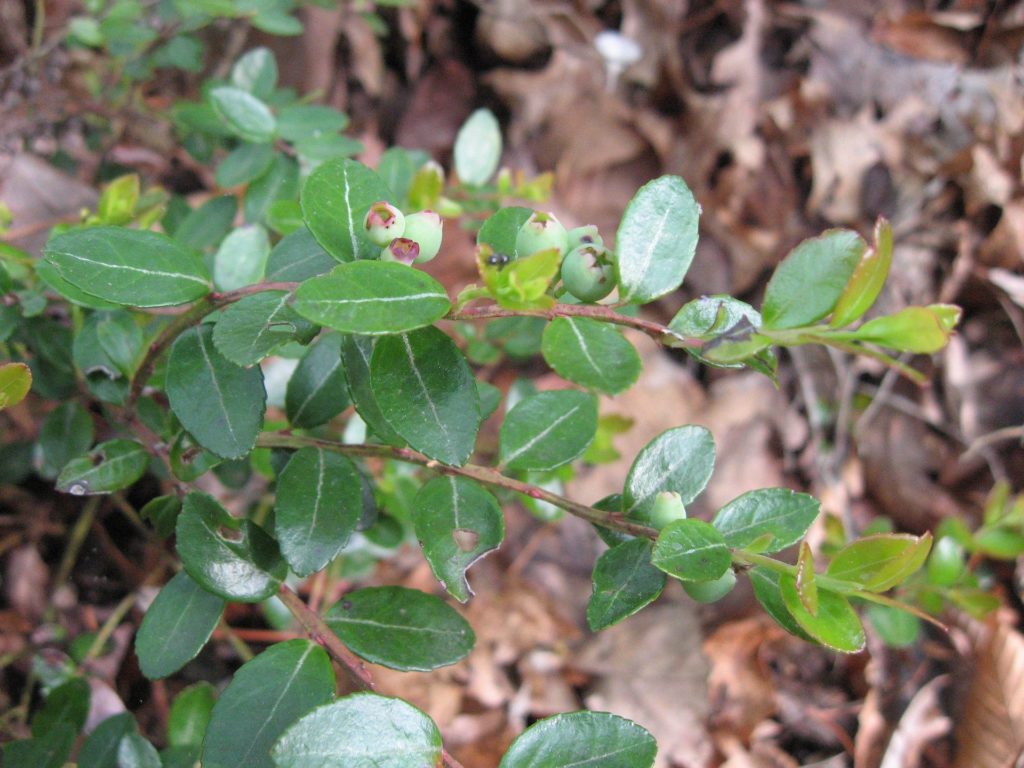
Gaylussacia brachycera, commonly known as box huckleberry, a survivor of the Ice Age, still lives in Pennsylvania.
That’s really a great conservation success story, but we are still often overlooking the consequences of lost pollinators on which plants rely. Who is working on identifying the missing pollinator in this case?
We don’t have anybody working on that particular species exactly, but there are a lot of people looking at that question across the state. We are working with Penn State on pollinator issues and pollinator questions. It’s really been eye-opening to see how they go so hand in hand. You can’t have one without the other. If you’ve got a plant that depends on a bug for pollination, if it’s not a wind pollinated plant, then you’ve got to conserve both of those things in order to make it work.
You were talking about the secret sanctuaries, and I wanted to say that not all of them are secret. Some of the sanctuaries that we have designated are very well-known places, such as the Hoverter and Sholl Box Huckleberry Natural Area, which is a small 10-acre reserve in Perry County, even though there is another undisclosed reserve location. This one was created 1967 to protect box huckleberries (Gaylussacia brachycera) and allow visitors to see them. It’s important and well known because the plant is one of the oldest organisms in North America and maybe the world, older than California redwoods, and thought to be a survivor of the Ice Age.
The box huckleberry is a very slow growing shrub that reproduces by putting out runners. It’s another species that has pollination problems. Nobody’s really sure what the pollinator of that species is or was, and there’s so few populations. The pollinator could still be around, but it can’t go far enough from one colony to the other to make the cross pollination. The populations that we have are primarily clonal. It’s just one genetic individual.
It reminds me of another large and ancient clonal colony—Pando, a forest of male quaking aspen in Utah. It’s an incredible golden-yellow color this time of year.
Box huckleberry is not a showy species and it’s not even a particularly beautiful species. It’s just a low growing shrub. But it’s pretty interesting that it’s one of the oldest plants the world.
Are box huckleberries in any danger due to climate change? I’ve read that the box huckleberry is vulnerable to rising temperatures and shifts in its flowering and fruiting cycles.
Yes, and my staff is very protective of it.
In this regard, there is another important project related to climate change that we funded for the Carnegie Museum. They are looking through their herbarium specimens and pulling out important rare species and then go to the same physical location when it should have been flowering. If the plant was known to be flowering in May and 1890, then they would go in May in 2019 to compare and see if the species were doing the same thing at the same time and see if there’s any changes in phenology. Are they blooming earlier? Are they blooming later? Are the pollinators around at that time of the year?
I haven’t gotten the final report yet, but I know they visited a lot of different sites and in some cases, they did have to go earlier than they had originally planned.
I feel really lucky that my job has a very big hand in the conservation of native plants in all of Pennsylvania and particularly on the 2.2 million acres of state forest land.
Gayil Nalls Ph.D. is the creator of World Sensorium and the founder of the World Sensorium/Conservancy.

As Ireland transitions from the rich, smoky scent of peat-burning to a more sustainable future, its olfactory heritage is evolving. What will become the next iconic aromatic symbol of Ireland?
Click to watch the documentary trailer.


